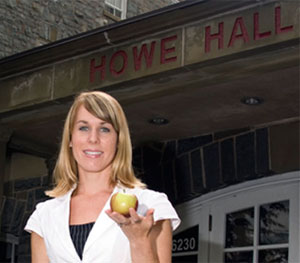 |
| An apple a day is better than fries. Angela Banks-Emmerson is a professional dietician with Aramark. (Bruce Bottomley Photo) |
Freedom tastes sweet, but it can come at a hefty price.
That‚Äôs a lesson many first-year university students learn when they arrive back home for holiday break and notice the bathroom scale acting a bit wonky. University weight gain is a subject of such notoriety that it even has its own catchy moniker: ‚Äúthe freshman 15.‚ÄĚ
‚ÄúIt might not be 15, but certainly five to 10 pounds for a number of students,‚ÄĚ says Angela Banks-Emmerson, a professional dietitian with Aramark. ‚ÄúTen is probably more average, but gaining 15 pounds is certainly not a stretch for some people.‚ÄĚ
Ms. Banks-Emmerson is working to provide more healthy options at AVĺ„ņ÷≤Ņ‚Äôs dining halls and to help students learn what it takes to eat better whether they live on or off campus.
‚ÄúA major factor in weight gain is that some students are on their own for the first time,‚ÄĚ she notes. ‚ÄúIn high school, students tend to be often more active and their parents may cook for them. Now they have access to a cafeteria where, if they choose, they can eat French fries and pizza every day.‚ÄĚ
Cut the calories
Food selection is one of three main reasons why a number of students gain weight when they arrive at university. Another is a decline in physical activity, with many students neglecting exercise in favour of studying and their social lives. The third factor is alcohol consumption, as most alcoholic drinks are loaded with calories, consumed late in the day and often paired with excessive eating.
In addition to getting more exercise and curbing their alcohol consumption, students can help ward off weight gain by choosing better foods, starting with the fundamentals.
‚ÄúSome people may feel that Canada‚Äôs Food Guide is simplified when fad diets are so trendy these days,‚ÄĚ explains Ms. Banks-Emmerson. ‚ÄúBut we have to get back to basics with real, whole fresh food.‚ÄĚ
She advises students to pay attention to what they‚Äôre eating and not to fret about waiting in line in dining halls for healthier options. She also recommends students make their own salads, choose lots of vegetables and lean proteins when creating meals. ‚ÄúYou should be filling half your plate with vegetables, ideally,‚ÄĚ she says.
Eating well
Aramark is doing its part to try and make healthy eating easier for students. This fall will see new healthy options with increased access to nutritional breakdown of menu selections. It will also continue adding to its brochure program with information on subjects such as fats, physical activity, vegetarian or vegan dining, and many more.
‚ÄúMany students want to eat healthy, but in today‚Äôs world it is hard to identify what is truly healthy. We‚Äôre trying to help with that. Ultimately, though, it comes down to the individual. You have to be passionate about the long term benefits of eating well.‚ÄĚ
READ: in The Globe and Mail
LINK:
